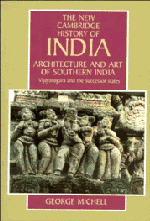Summary
The purpose of this essay, which follows the layout of the sequence of chapters, is to list the most important bibliographical references for each topic. Publications are cited by author(s), or by city in the case of certain exhibition catalogues, and date of publication. More complete informations is given in the Bibiography (pp. 283-94). Only works in European languages appear.
The best bibliographical starting point for Southern India under Vijayanagara is Rajasekhara (1985), who has compiled the largest number of publications dealing with the era, including pertinent archaeological and epigraphical sources; unfortunately, there are no subdivisions according to subject. A better organised, though somewhat select bibliography is the essay included in Stein (1989:147-51). Here, however, there are only occasional references to studies on architecture and art.
introduction
No comprehensive works are yet available that satisfactorily encompass the history of building, sculpture and painting in Southern India during the Vijayanagara and Nayaka periods. Publications that may appear at first to offer extensive treatments, such as Saletore (1982) and Rajasekhara (1983), are in fact mostly concerned with monuments at the Vijayanagara capital. Articles and chapters in general surveys provide only the barest introduction to the subject: Sarma Rao (1946-7), Goetz (1959:188-93), Bussagli and Sivaramamurti (1971:264-9), Huntington (1985:chs. 23-5) and Harle (1986:chs. 23-4). The somewhat summary coverage in these publications does not mean that Southern Indian buildings and art works from this era have always been unappreciated. Pioneering studies are by Fergusson (1876), Chisholm (1876, 1883) and Gopinatha Rao (1914-16).
- Type
- Chapter
- Information
- Architecture and Art of Southern IndiaVijayanagara and the Successor States 1350–1750, pp. 278 - 282Publisher: Cambridge University PressPrint publication year: 1995

